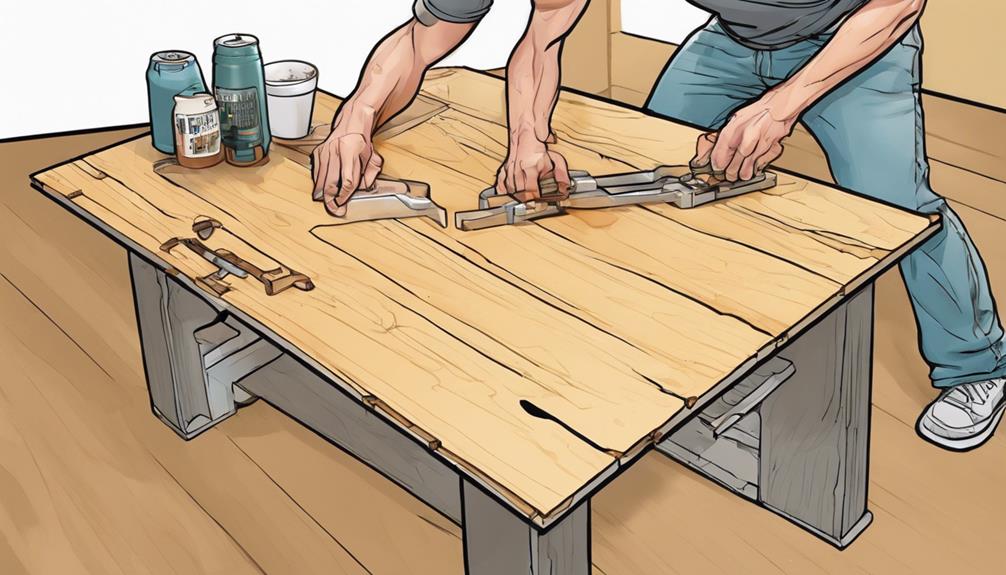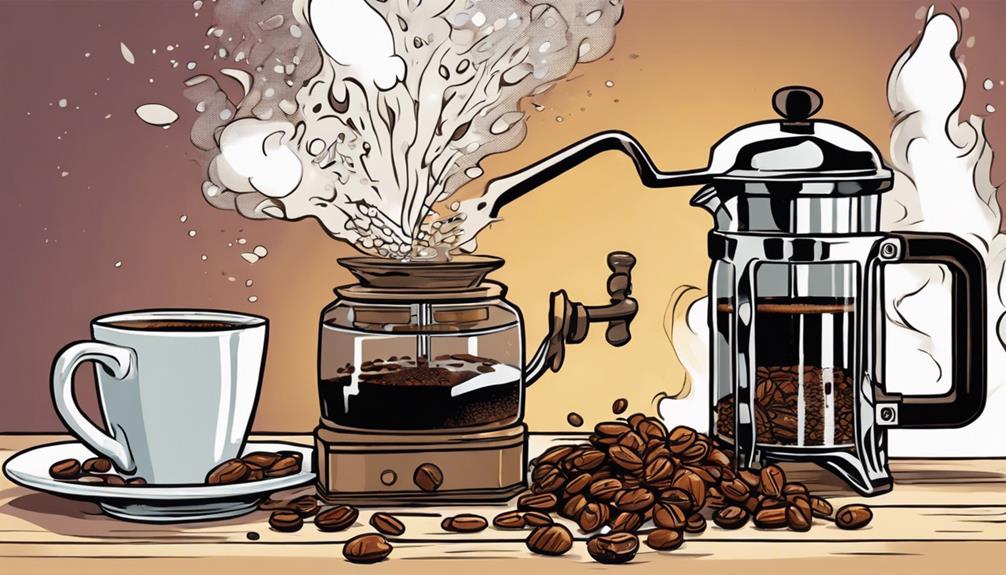Transform your paper with a vintage touch by aging it using coffee. Dilute instant coffee in hot water, apply and bake for a unique retro appearance. Experiment with different shades to add character. Be cautious of tea staining for archival concerns. Explore crafting origami, art journals, and home decor with aged paper. Enhance the effect by crumpling or burning the edges. For Halloween cards, use spooky stamps and ink for an ancient look. Remember to dry thoroughly for the best results. Curious to learn more techniques and tips for aging paper successfully?
Translate with U.S. English:
Transform your paper with a vintage touch by aging it using coffee. Dilute instant coffee in hot water, apply and bake for a unique retro appearance. Experiment with different shades to add character. Be cautious of tea staining for archival concerns. Explore crafting origami, art journals, and home decor with aged paper. Enhance the effect by crumpling or burning the edges. For Halloween cards, use spooky stamps and ink for an ancient look. Remember to dry thoroughly for the best results. Curious to learn more techniques and tips for aging paper successfully?
Key Takeaways
- Dilute instant coffee for a retro stain.
- Quick dry paper at 200 degrees for 2 mins.
- Experiment with coffee concentrations for varied shades.
- Crumple paper after staining for vintage effect.
- Incorporate tips for an authentic retro look.
Fast Coffee Staining Technique
To achieve a fast coffee staining technique for aging paper, start by diluting 2 tsp of instant coffee in 1/4 cup of hot water. This concentrated coffee solution will impart a rich, warm color to your paper, giving it that sought-after vintage appearance. Once you've prepared your coffee mixture, use a brush or sponge to apply it to the paper evenly.
Experiment with the concentration of the coffee mixture to achieve different shades of aging, allowing you to customize the look of your project.
After applying the coffee stain, you can speed up the drying process by baking the paper at 200 degrees for about 2 minutes. This quick technique not only helps in achieving a retro look but is also ideal for incorporating vintage vibes into various crafts and art projects.
Coffee staining provides an easy and effective way to add character and antiquity to your paper creations.
Archival Concerns With Tea Staining
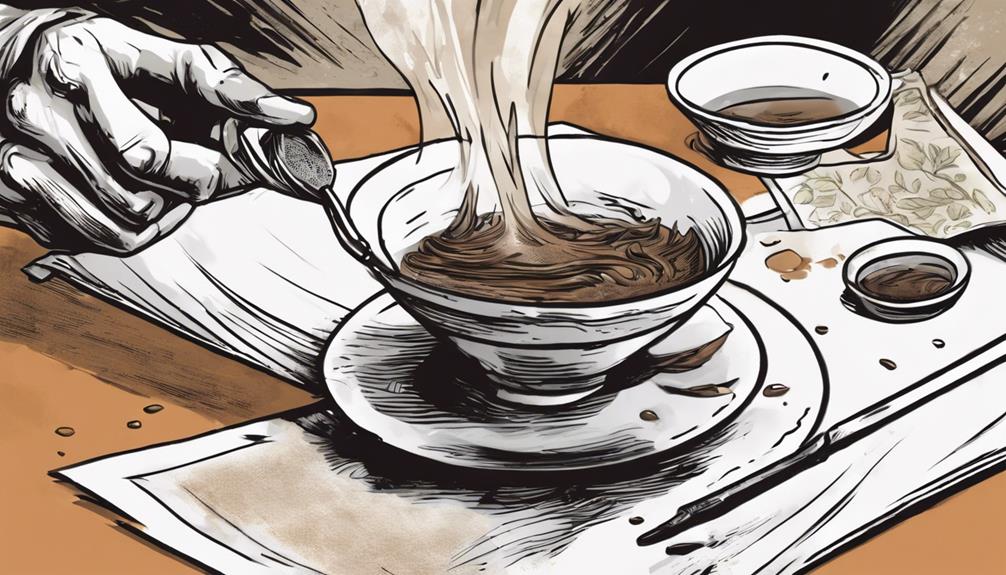
When tea staining paper for a vintage appearance, it's crucial to take into account the archival concerns associated with this method.
The tannic acid found in black tea can affect the longevity and quality of the paper, resulting in yellowing and fragility over time.
Conservationists recommend refraining from tea staining significant or fragile documents to guarantee their preservation.
Archival Implications of Tea Staining
Tea staining poses significant archival concerns due to the presence of tannic acid in black tea, which expedites the degradation of paper fibers over time.
When paper is stained with tea, the tannic acid interacts with the cellulose in the paper, leading to a breakdown of the fibers. This process can result in the paper losing its archival quality, making it susceptible to discoloration, brittleness, and potential damage.
The tannic acid's impact on paper fibers raises concerns about the long-term preservation of documents or artwork that have been tea-stained.
To maintain the archival integrity of your paper creations, it's advisable to explore alternative aging techniques that don't incorporate tannic acid. By being mindful of the materials and aging methods you use, you can guarantee that your vintage-inspired pieces stand the test of time without compromising their archival quality.
Preservation Concerns With Tea Aging
Consideration should be given to the preservation concerns associated with tea aging, particularly in relation to the archival implications of tannic acid's impact on paper fibers. When aging paper with tea, the presence of tannic acid can lead to a loss of archival quality as it degrades the paper fibers over time. The acidic nature of tannic acid poses a risk to the long-term preservation of aged paper, making it unsuitable for important documents or artwork that require archival standards. It is advisable to explore alternative aging methods that do not compromise the archival quality of the paper.
| Preservation Concerns With Tea Aging |
|---|
| Affects archival quality of aged paper |
| Tannic acid degrades paper fibers over time |
| Risk of deterioration due to tannic acid |
| Not suitable for preserving important documents |
| Consider alternative aging methods |
When considering aging paper for a retro look, it is essential to weigh the trade-off between aesthetic appeal and long-term preservation to maintain the integrity of the documents or artwork.
Tannic Acid Impact on Archival Quality
To preserve the archival quality of aged paper, it's vital to address the impact of tannic acid found in black tea staining. Tannic acid, present in black tea, can expedite the deterioration of paper by weakening its fibers over time.
The acidic nature of tannic acid contributes to the yellowing and brittleness of aged paper, raising archival concerns when using tea staining for important or long-term documents. The presence of tannic acid in tea can jeopardize the longevity and preservation of paper, making it less suitable for archival purposes.
It's advisable to explore alternative aging methods that don't involve tannic acid to guarantee the longevity and durability of important documents. By avoiding tannic acid in tea staining, you can mitigate the risks associated with decreased archival quality and safeguard your documents for future generations.
Versatile Aged Paper Projects
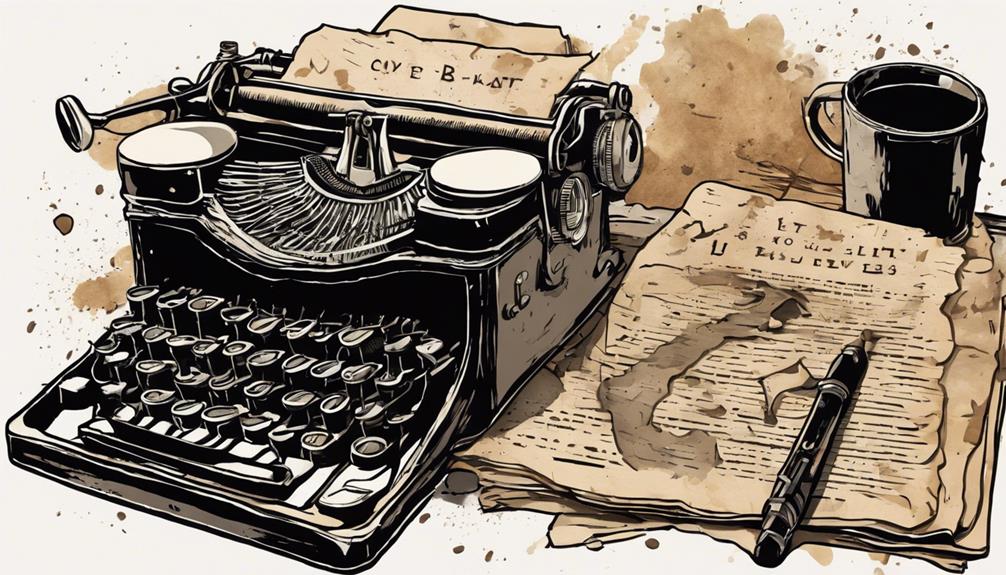
You can explore a multitude of project ideas with aged paper, ranging from scrapbooking to creating unique home decor pieces.
Experimenting with different decorative techniques like painting characters or scenes can elevate the vintage appeal of your crafts.
Let your creativity flow as you discover the endless possibilities that aged paper offers for your artistic endeavors.
Project Ideas
Exploring various ways to utilize aged paper in creative projects can lead to unique and visually appealing results. When it comes to incorporating aged paper into your crafts, the possibilities are endless. Here are some project ideas to get you started:
| Project Ideas | Description |
|---|---|
| Paper Crafts | Create intricate origami pieces or delicate paper flowers for a vintage feel. |
| Coffee or Tea Stained Art | Experiment with using different concentrations of coffee or tea to age paper for unique artwork. |
| Art Journals | Use aged paper as a base for your art journal pages, adding depth and character. |
| Home Decor | Incorporate aged paper into wall art, photo frames, or DIY vintage-inspired furniture. |
Whether you enjoy scrapbooking, card making, art journals, or simply want to add a retro touch to your home decor, aged paper can elevate your projects with a nostalgic charm. So grab your coffee or tea, start aging that paper, and let your creativity flow!
Decorative Techniques
Get ready to harness your creativity with versatile decorative techniques using aged paper for your projects. One popular method to make paper look old is by baking it in the oven on a cookie sheet. This technique not only adds an authentic antique look to your paper but also helps in achieving a vintage vibe for your crafts. By carefully monitoring the baking time and temperature, you can control the level of aging to match your desired aesthetic.
Aged paper is perfect for a wide range of projects, including scrapbooking, card making, art journals, and home decor. For example, creating vintage Christmas canvas art using aged paper can bring a festive touch to your holiday decorations. Additionally, aging book pages from your favorite novels can result in personalized and unique gifts that showcase your creativity.
Explore the possibilities of using aged paper as a canvas for painting characters or scenes. Experiment with different concentrations of coffee or tea to achieve varied results in aging paper, allowing you to customize your projects to suit your artistic vision.
Paper Aging Tutorial Steps
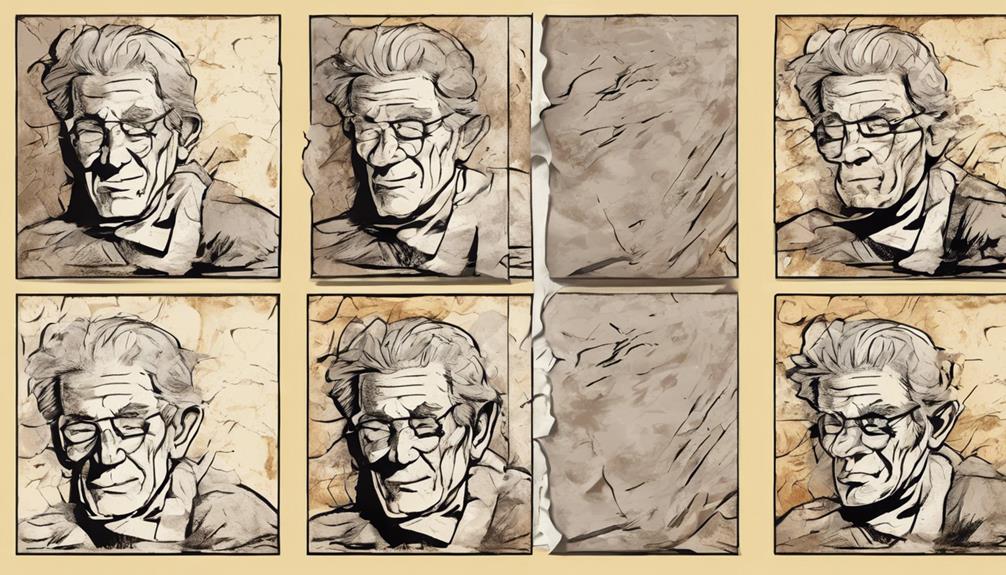
To begin the paper aging process, brew a strong batch of coffee to achieve the desired retro look on white paper. Using a brush, apply the coffee onto the piece of paper until you reach the shade of aging you prefer. Afterward, bake the paper at 200°F for 5-10 minutes to set the aging effect. For an extra vintage touch, stamp designs on the aged paper using brown pigment ink. Finally, trim the paper to your desired size and rub brown or black ink along the edges for a polished finish.
| Paper Aging Tutorial Steps |
|---|
| 1. Brew strong coffee |
| 2. Apply coffee to paper |
| 3. Bake at 200°F for 5-10 minutes |
| 4. Stamp designs using brown ink |
These steps will help you achieve that perfect retro look for your paper, adding a touch of nostalgia to your projects.
Necessary Materials and Preparation
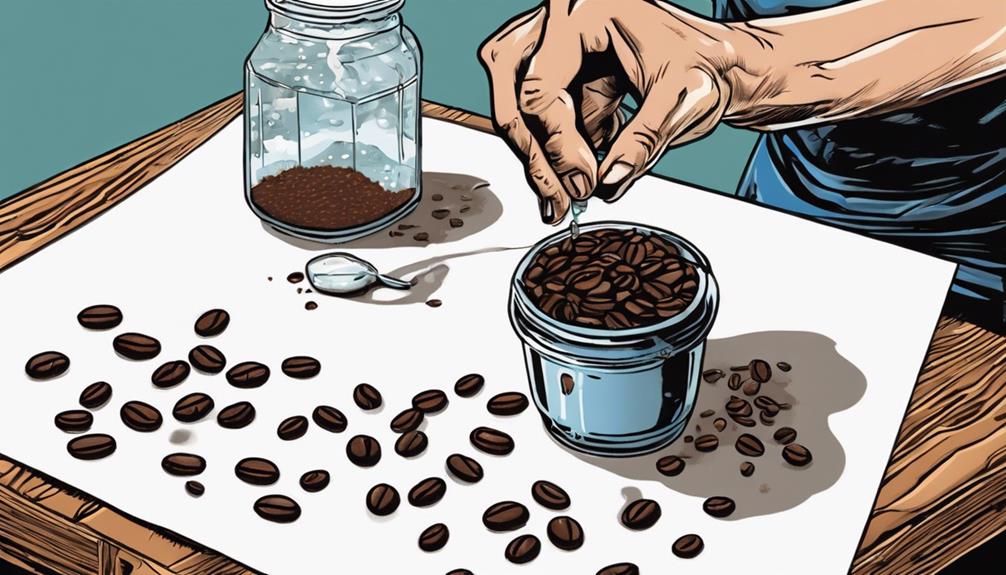
Consider using white paper or cardstock for aging with coffee to achieve the desired retro appearance. Start by brewing a strong cup of coffee and allowing it to cool. Place your piece of paper on a baking sheet to prevent any mess. Then, use a sponge or brush to evenly apply the coffee to the paper, making sure to cover the entire surface. You can also try dabbing the coffee on the paper with a paper towel for a more speckled effect. Let the paper dry completely before using it for any project. For an extra vintage touch, consider using this technique for creating recipe cards for your favorite Swedish coffee bread recipe.
Once your coffee is at room temperature, pour it into a shallow container. Dip a brush or sponge into the coffee and make sure the entire piece of paper is covered for an even effect. Experiment with different concentrations of coffee to achieve varying shades of aging.
If you want to add a fragrant touch to your aged paper, consider mixing in some cinnamon or vanilla extract with the coffee. Once you have achieved the desired appearance, allow the paper to dry completely before moving on to the next steps in the vintage paper aging process.
Enhancing the Vintage Paper Effect
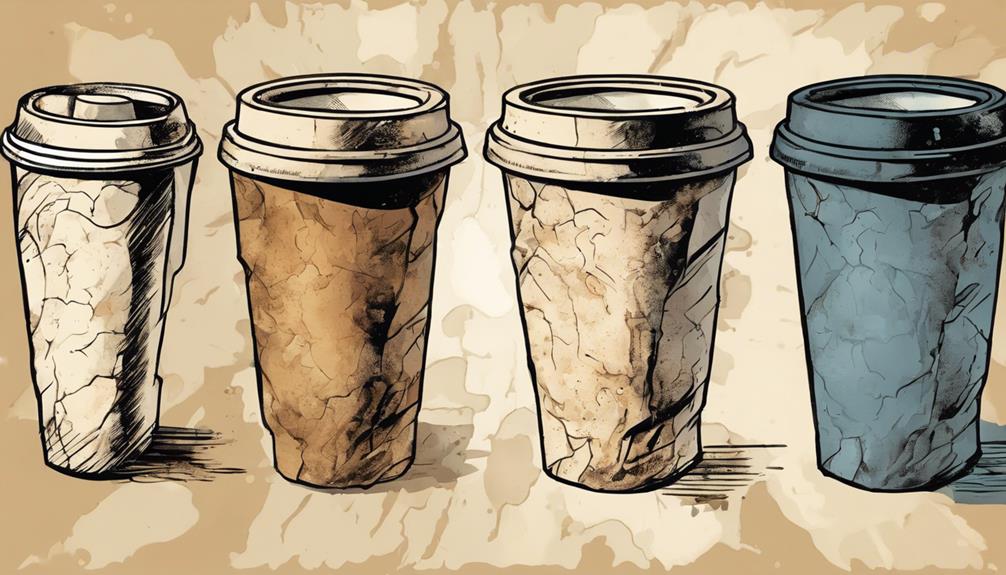
Enhance the vintage paper effect by incorporating various techniques to further age and distress the paper, elevating its retro aesthetic. Begin by crumpling the paper before staining it with coffee crystals to achieve a distressed and aged appearance.
Use a sponge brush to add a concentrated coffee or tea solution in specific areas for dark, aged spots on the paper. For an antique look, consider lightly burning the edges of the aged paper.
To create a sepia tone effect, apply a light coat of diluted coffee solution evenly across the paper. Once the paper has been aged to your liking, press it under heavy books to flatten and dry completely.
Spooky Halloween Card Making

For spooky Halloween card making, incorporate Halloween-themed rubber stamps and aged paper effects using coffee staining and baking techniques. To create eerie and unique cards, follow these steps:
- Choose Spooky Rubber Stamps: Opt for Halloween-themed rubber stamps like 'If Youve Got It, Haunt It' and 'Trick or Treat Yo Self' to add a touch of spookiness to your cards.
- Age Paper with Coffee Staining: Brush strongly brewed coffee onto white card stock paper to achieve an aged look reminiscent of ancient scrolls.
- Bake for Vintage Appeal: Bake the coffee-stained paper at 200°F for 5-10 minutes to enhance the vintage effect and make sure the ink sets properly.
- Add Authentic Touches: Trim the paper to size, then rub brown or black ink along the edges for an authentic, aged appearance that will make your Halloween cards stand out.
Experiment with different stamps and techniques to create personalized and spooky Halloween cards that will send chills down anyone's spine.
Tips for Aging Paper Successfully
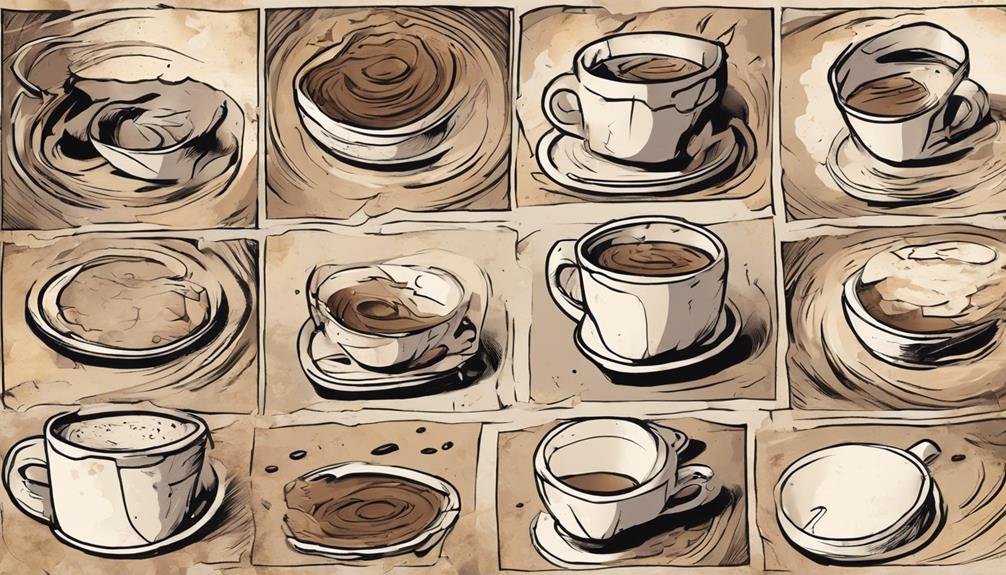
Wondering how to achieve the perfect aged look for your paper projects? Follow these tips for aging paper successfully. For a detailed guide to aging paper, consider the following techniques:
| Tip | Description |
|---|---|
| Dilute Instant Coffee | Mix 2 tsp of instant coffee in 1/4 cup hot water to create a coffee stain for an aged appearance. |
| Quick Drying with Heat | Bake stained paper at 200 degrees for 2 minutes to expedite the drying process. |
| Experiment with Tea Staining | Try different concentrations of tea for varied aging results, but be aware of potential quality loss. |
When aging paper, remember that crumpling the paper after staining can enhance its distressed and aged appearance. By incorporating these tips into your paper projects, you can achieve an authentic vintage look that will elevate your creations.
Frequently Asked Questions
How Do You Make Paper Look Vintage With Coffee?
To make paper look vintage with coffee, dilute 2 tsp of instant coffee in 1/4 cup hot water. Apply the solution with a brush or sponge, then bake at 200 degrees for 5-10 minutes. Experiment with concentrations for varying shades.
How to Make Printed Paper Look Old?
To make printed paper look old, layer ink prints like storytelling chapters. Blend distressed inks on diverse paper, creating a vintage masterpiece. Stamp textures, mix colors, and post-stamp for a retro feel. Turn ordinary prints into timeless treasures.
How to Tea Stain Paper to Look Old?
To tea stain paper to look old, steep a tea bag in hot water for 1 min. Apply the solution on white paper with a brush. Let it air dry for 2-3 hours or bake at 200 degrees for 2 min for a quicker result.
How Do You Age Shiny Paper?
To age shiny paper, crumple it for texture, sand lightly for a vintage look, apply diluted coffee or tea for stains, distress edges with a heat tool, and try techniques like ink distressing for a retro vibe.
Conclusion
Now that you've learned how to age paper for a retro look, the possibilities are endless! Just like a fine wine, paper only gets better with age.
So grab your supplies, get creative, and watch as your projects transform into timeless pieces with a vintage vibe.
Remember, aging paper is an art form that adds character and charm to any project, so don't be afraid to experiment and have fun with it!



